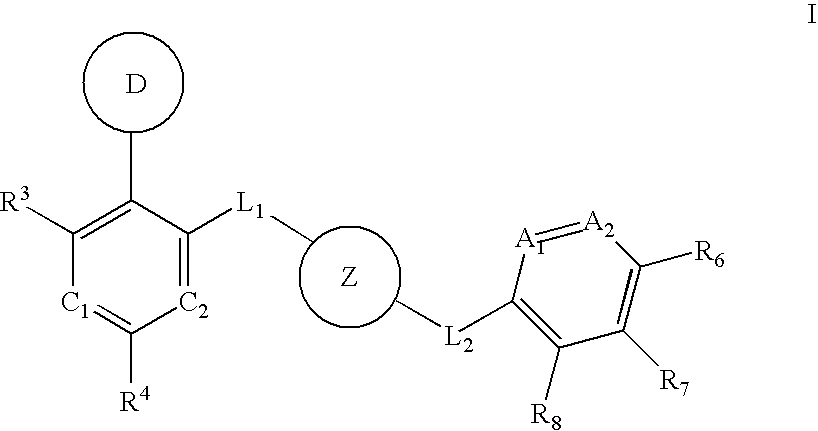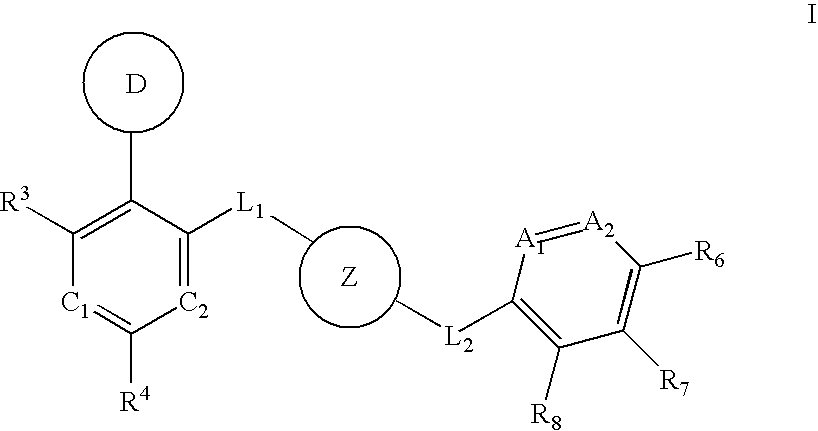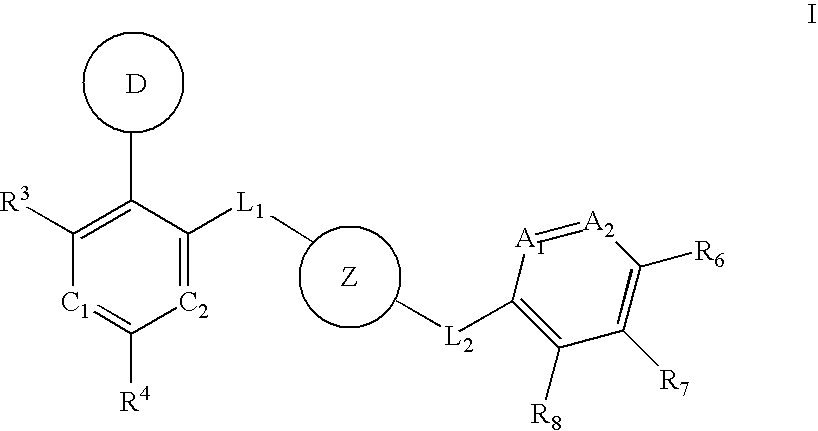Aurora kinase modulators and method of use
a kinase and Aurora technology, applied in the field of pharmaceutical agents, can solve the problems of affecting mankind and a major cause of death worldwide, few offer any considerable degree of success, and loss of normal cell proliferation regulation,
- Summary
- Abstract
- Description
- Claims
- Application Information
AI Technical Summary
Benefits of technology
Problems solved by technology
Method used
Image
Examples
example 1
[0323]
Synthesis of 2-chloro-4-(2-chloro-pyridin-3-yl)-[1,3,5]triazine
Step 1
Preparation of 2-chloro-nicotinamidine
[0324]2-Chloro-3-cyanopyridine (5.0 g, 36 mmol) was dissolved in dry EtOH (100 mL) at 0° C. HCl was bubbled through the mixture for 3 h and the mixture was sealed and refrigerated (about 8° C.) overnight. After concentration, the residue was stirred with ammonium acetate (5.5 g) in 100 mL IpOH. After 12 h, the pH was adjusted to 9 (from 4) using concentrated NH4OH solution, and stirring continued two more days. The mixture was concentrated and purified by flash chromatography (10:1:0.1 CH2Cl2 / MeOH / NH4OH). Trituration in hot tBuOMe / IpOH removed some residual amide side-product to provide the product as a white solid.
Step 2
Preparation of amino-(2-chloro-pyridin-3-yl)-methylcyanamide
[0325]2-Chloro-nicotinamidine was suspended in 10 mL IpOH with 500 mg solid cyanamide and the stirring solids were dissolved by addition of 5% aqueous NaHCO3 (30 mL). After two days stirring, the...
example 2
[0327]
Synthesis of [4-(2-Chloro-pyridin-3-yl)-[1,3,5]triazin-2-yl]-methyl-amine
[0328]To 2-chloro-4-(2-chloro-pyridin-3-yl)-[1,3,5]triazine (10.0 g, 44.0 mmol) in 55 ml of methylene chloride was added methylamine (45 ml, 88.0 mmol) as a 2.0 M solution in THF at 0° C. After stirring at room temperature for 18 h, the mixture was diluted with acetone and filtered through a plug of silica gel and concentrated to yield the desired product. MS m / z=222 [M+H]+. Calc'd for C9H8ClN5: 221.65.
example 3
[0329]
Synthesis of 4-(2-Chloro-pyridin-3-yl)-pyrimidine
Step 1. Preparation of 1-(2-Chloro-pyridin-3-yl)-3-dimethylamino-propenone
[0330]1-(2-Chloro-pyridin-3-yl)-ethanone (21.7 g, 139 mmol) in 46 mL N,N-dimethylformamide, dimethyl acetal (42 g, 350 mmol) was heated under a drying tube at 85° C. for 1.5 h and concentrated. The residue was purified by suction filtration chromatography (using 150 g silica in a Buchner funnel, with rapid collection of fractions eluting with 10:1 and then 5:1 CH2Cl2 / IpOH) to provide yellow solid product. MS m / z=211 [M+H]+. Calc'd for C10H11ClN2O: 210.66.
Step 2. Preparation of 4-(2-Chloro-pyridin-3-yl)-pyrimidine
[0331]Sodium methoxide was generated over a period of 1.5 h by the intermittent addition of small chunks of sodium metal (8.3 g total, 360 mmol) to 400 mL dry methanol under N2 at room temperature, using a bath of 500 mL IpOH at room temperature as a heat sink. Formamidine acetate (42.7 g, 410 mmol) was added, followed ten minutes later by the enam...
PUM
| Property | Measurement | Unit |
|---|---|---|
| temperatures | aaaaa | aaaaa |
| temperatures | aaaaa | aaaaa |
| flow rate | aaaaa | aaaaa |
Abstract
Description
Claims
Application Information
 Login to View More
Login to View More - R&D
- Intellectual Property
- Life Sciences
- Materials
- Tech Scout
- Unparalleled Data Quality
- Higher Quality Content
- 60% Fewer Hallucinations
Browse by: Latest US Patents, China's latest patents, Technical Efficacy Thesaurus, Application Domain, Technology Topic, Popular Technical Reports.
© 2025 PatSnap. All rights reserved.Legal|Privacy policy|Modern Slavery Act Transparency Statement|Sitemap|About US| Contact US: help@patsnap.com



